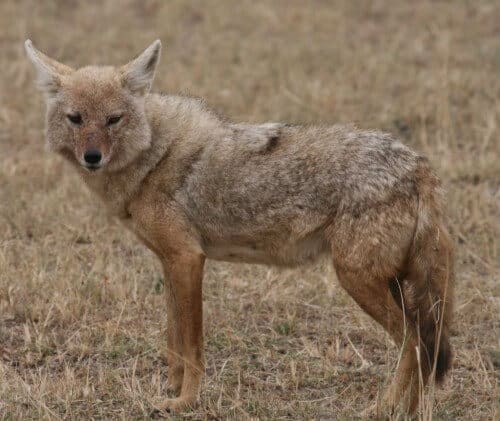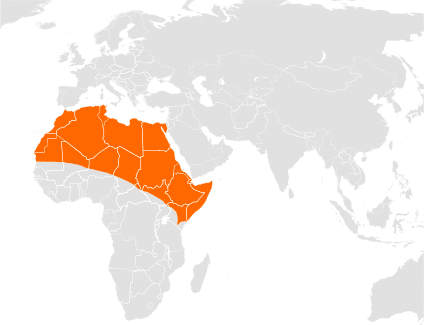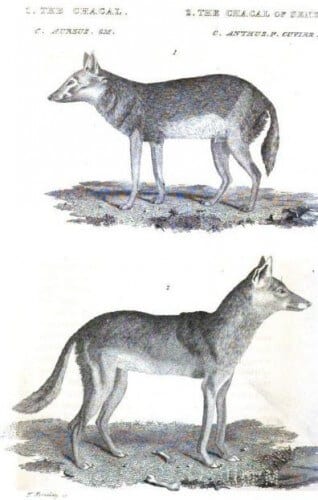The African golden wolf has fooled scientists for 150 years. Now researchers have finally managed to reveal his true identity
Dr. Uri Palavitz", Angle - news agency for science and the environment

From time to time exciting news about the discovery of a new species appears in the scientific press. The thought that there are species of animals, plants, fungi and other organisms that we have not yet met on Earth is a fascinating and exciting thought, which leads scientists to go out and look for those elusive creatures. When a new species is discovered, researchers give it a scientific name according to scientific rules and associate it with one or another group of organisms. In the past, scientists sorted and classified organisms mainly based on morphological characteristics and the habitat, but today there are other tools that are more accurate and objective, and all this thanks to the ability to extract DNA and perform genetic comparisons.
Although over 1.6 million organisms have been described so far, thousands of new species are still discovered every year. Furthermore, the estimates of naturalists speak of millions of organisms that have yet to be discovered and described by science. Generally, the best chance of finding new animal species is through challenging research expeditions to the most remote parts of the planet such as the thick of the rainforest or the dark depths of the oceans.
parallel evolution
The story before us is completely different. This is not a story about a daring journey to forgotten parts of the country and it is not about an animal that human eyes have not yet seen. This is the story of a jackal, quite common, which is not a jackal at all.

Jackals are carnivores belonging to the canine family. Golden jackal populations are common in Southeastern Europe, Southwestern and Central Asia, the Middle East and Africa (see figure). Based on the similar appearance, living environment and behavior, these populations were considered to belong to one species (Canis aureus). The golden jackal population in Egypt and North African countries was considered a subspecies of the golden jackal. The widespread distribution of the golden jackal aroused the curiosity of the scientists and they decided to check whether all the populations really belong to the same species. Surprisingly, in two studies (here and here) conducted on different populations of golden jackals in North and West Africa, it turned out that genetically these populations are closer to wolves than to golden jackals. However, populations of golden jackals from East Africa have not been studied. In a recently published comprehensive study, a large international group of scientists led by Klaus-Peter Koepfli carried out a large-scale genetic comparison between gray wolves (Canis lupus), Ethiopian wolves (Canis simensis) and golden jackals from Eurasia, and from various regions of Africa including East Africa The research findings show unequivocally that the Eurasian jackal and the African golden jackal (over all its populations) are in fact two different species and that the latter is in fact genetically closer to the gray wolf.
According to the researchers' calculations, the Eurasian golden jackal split from the coyote and the gray wolf about 1.9 million years ago, while the African golden jackal split from them about 1.3 million years ago. Based on the results of the study, the researchers gave the African golden jackal a new scientific name - Canis anthus, and even offered it a new popular name - African golden wolf.
The African golden wolf has fooled scientists for 150 years mainly due to its great physical resemblance to the golden jackal, a similarity that probably stems from a similar lifestyle, environment and diet. Such a process is known as parallel evolution, which is defined as the development of similar traits in organisms of similar origin but which are not very close to each other. Parallel development results from adaptations to a similar living environment or form of life, but parallel evolution should not be confused with convergent evolution, which is the independent development of similar characteristics in creatures of completely different origin (for example, the development of flight in birds, bats and pterosaurs - a group of flying reptiles that became extinct).

Israel, a meeting point
The research of Kopfeli and his colleagues also has an interesting and fascinating Israeli aspect. One of the participants in the study is Prof. Eli Geffen from the Department of Zoology at Tel Aviv University. Geffen provided the research with DNA that was extracted from cats and gray wolves from Israel. The findings from the Israeli jackals, which are geographically closest to Africa, were unusual: some of the jackals are indeed golden jackals while other individuals, from other populations in Israel, were discovered to belong to the African golden wolf. That is, for the first time it becomes clear that Israel is the seam between the two species (golden jackal and golden wolf) and they coexist there.
What is the exact geographical distribution of the populations of both sexes in Israel, are there hybrids among them and other questions are intriguing questions that require further research to answer them. Such research is already being carried out in practice and in the near future we will be able to get preliminary answers to these questions.
The golden jackal in Israel
The Eurasian golden jackal is common all over our country and can be seen near human settlements. The activity hours of the jackals are mainly at night, but they can also be seen at dusk and in the early morning hours. The golden jackal, like the other canines, is a social animal that lives in pairs or small packs and communicates through the famous howls of jackals. The jackal is an omnivore that feeds on small mammals, birds, reptiles and carcasses, but also on fruits and vegetables. As a predator that eats carrion and rodents the jackal is of ecological and agricultural importance. On the other hand, jackals also harm farm animals, orchards and vineyards, and are also considered a species that spreads rabies. The fear of the spread of rabies at the time (1964) led the Ministry of Agriculture to embark on a boycott war against the jackals by dispersing poisonous substances. These poisonings have indeed hit the jackal population very hard, but also many other animal species, including carnivores. In the years after the poisoning, as a result of the decrease in predators, there was a population explosion of rodents that caused severe damage to agriculture. Following the severe consequences of those poisonings, the jackal was included in the list of legally protected species and since then its populations have recovered. It is very possible that the same poisoning allowed the resettlement of migrating jackal populations, but it is not clear for now where exactly they came from.

10 תגובות
Many thanks for bringing the fascinating subject and bringing it up for discussion. We live in Mount Amsha where many jackals especially hear them in the evening from their choirs. Every time I see a jackal, I cross my mind.. maybe it was actually a wolf.. a small wolf similar to a jackal. The size in normal and unequipped observation is a very problematic measure especially when the size differences in Israel are probably not noticeable. The color is also problematic. In general, the name of the species "golden jack" may also mislead because it is actually not that golden, and it depends very much on the light conditions, but even in daylight they look quite dark. – Is there a difference in color between male and female? In general, the structure of the face, ears and tail look remarkably similar to a wolf. What seems to be evident in my opinion, is that they are a little more bent down, looking and searching close to the ground. less upright and brave like wolves.
Hello Livlit (?)
First, thanks for the correct correction to Herzl's response.
The wikipedia page was recently updated based on the Koppli article that I report on in the article so it certainly matches. Regarding your question regarding the behavioral differences, in my opinion the golden wolf also hunts singly or in pairs and not in packs and therefore the prey is indeed smaller than in the pack gray wolf.
Hello light,
There is no single accepted definition for the term biological sex and the long-standing debate will probably continue for quite some time. It should be understood that we, humans, try to give unequivocal definitions to something that is not black and white. There are constantly processes of differentiation and creation of new species. There are many shades of gray in nature, so it is difficult to find one unequivocal definition. The approach followed in the current article is an approach of sorting species based on genetic analysis (+morphological comparison). The analysis was done on several types of DNA and on the comparison of different regions of the DNA.
If you are interested in reading more, I recommend the following sources:
https://en.wikipedia.org/wiki/Species
http://eva.universidad.edu.uy/pluginfile.php/296139/mod_resource/content/0/Hausdorf_2011_species_concept.pdf
http://www.pnas.org/content/102/suppl_1/6600.full#abstract-1
I will start by correcting the commenter "Herzl" who stated that "jackals when they enter an urban area try to prey on children and therefore their blood is allowed"
Golden jackals are not dangerous to humans (except for individuals infected with rabies) and are much less dangerous to humans than dogs.
There are no known cases in which healthy jackals not infected with rabies attacked humans on their own initiative and not in self-defense. There are cases where coyotes (to be precise then probably a hybrid between coyotes and wolves) attacked humans (adults) and wolves attacked humans. And as everyone knows there are quite a few records of people being attacked by dogs.
But there is no record (as far as I know, and I've done quite a bit of digging on the subject) of jackals attacking humans without them being rabid or the humans endangering the jackals' cubs and then the jackals protecting the pack or in self-defense.
I have been researching and documenting golden jackals for a long time. There are notable differences in the conduct of the jackals
compared to wolves. One of the most notable differences is that jackals hunt individually almost completely and therefore they also hunt small prey (mainly rodents and even insects) while wolves tend to hunt in packs and large prey.
Is this difference also reflected in the differences between the golden jackal and the golden wolf?
Also, is the "family tree" or map of evolutionary development presented in the body of the article in the following link and in other places correct and consistent with the findings presented here?
https://en.wikipedia.org/wiki/Golden_jackal
Hello Dr. Palavitz,
Interesting article. Can you elaborate on how species are currently sorted? What does "the definitions for today's species are based on molecular genetic tools" mean? What tools? What settings?
What other sources would you recommend to those interested in reading?
Thanks in advance
light
Hi Herzl,
The story in North America is a little different since the genetic distance between the coyote and the gray wolf and the red wolf is relatively close and they are able to produce offspring informally known as coywolf. Furthermore, in the genus Canis there are almost no reproductive barriers and almost all of them can produce fertile offspring as a result of hybridization between different canine species. There is a long debate among scientists on how to treat these hybrid species and meetings and conferences are held on these topics.
Hello Assaf,
The traditional definition that you mentioned a long time ago is no longer valid and anyway you can't test any two species in nature to see if they interbreed. For example, there are many organisms that do not reproduce sexually or reproduce asexually as well. Today's species definitions are based on molecular genetic tools (although the morphology and place of the animals also have meaning). When they compared the DNA of golden jackals from different populations, they discovered that they are actually two different species, even phylogenetically distant.
With the development of molecular tests that allowed genetic comparisons
New species began to "emerge",
This is how the gorillas were divided into two species,
Recently a species of Lilith was added
And now the separation between the jackals,
Let the judges tell the public what the number of differences are
that determine a separate sex and what are the indicators for a separate sex?
Because it is possible that according to the same indicators for which the jackals are separated
It will be possible to separate the different "races" of man
For separate species?
The traditional definition of associating individuals with a species is:
When two individuals give birth to fertile offspring,
if and when :
The African golden "wolf" ("Canis anthus")
and the Eurasian Jackal (Canis aureus)
Set fertile offspring
After all, despite the genetic differences, they must belong to the same species,
Just like the gray wolf (Canis lupus)
and all breeds of dogs (Canis lupus Familiaris)
Belongs to a sex sign...
or state unequivocally that the traditional definitions
From B and T to T and T!
Also in North America there is a similar story of animals called "red wolves" that look halfway between a jackal and a wolf. Ten or twenty years ago there was a big debate about whether they are an independent species or a subpopulation of wolves or jackals, and whether they should be protected (as wolves - protected in many states in the US) or whether it is permissible to destroy them (jackals when they enter an urban area try to prey on children, so their blood is allowed) . It is not clear to me what the situation is today with DNA tests.